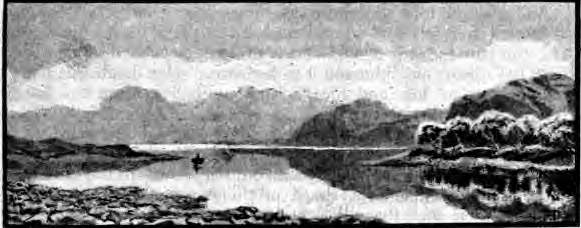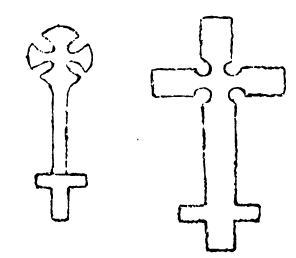|
ISLE MAREE was as sweet a spot at the end of the
ninth century as it is now. A thick grove of tall trees crowded round its
circular Druidical enclosure. There were noble specimens of the indigenous
oak, so mysteriously connected with the Druidical worship; there was a
dense thicket of the smooth-leaved holly, the sacred tree brought here by
St Maelrubha himself, who, it would seem, intended it to become (as it
did) a Christian rival to the Pagan oak. Then, as now, the undergrowth of
ferns and flowers, and a large kind of grass, attained almost tropical
proportions beneath the benign influence of the warm shade.
The scene of our story is laid in this beautiful and
hallowed island. St Maelrubha had been long gathered to his fathers, and
the sacred college of Iona had appointed a successor to his hermitage on
Isle Maree, who in turn had made room for another. The occupant of the
cell at the date of our story is an aged saint of peculiar sagacity and
piety. Long known to the wild people of Gairloch for his bold
denunciations and shrewd penetration, he had acquired by his stern
eloquence and ascetic life an extraordinary influence over them. The
Christian festivals brought successive offerings to the sainted hermit,
and the island oft resounded with the psalms of David chaunted by the
throng of faithful pilgrims.
But not only the common people resorted to
the cell of the holy man; the Norse Vikings, who held the district in
partial subjugation, frequently came to him for the ministrations of
religion and for the benefit of his sage counsel. To one and all, to young
and old, to Celt and Norwegian, he was alike accessible.
A young Norwegian prince was chief among the Vikings
who then dominated this part of the west coast. Prince Olaf was of the
blood royal of Norway, and on this account alone would have been willingly
adopted by his fellows as their leader, had not his personal bravery and
reckless daring secured to him the post of honour. He had a grievous
failing,—a restless and ungovernable temper. Naturally high-spirited, he
had been as a boy the spoilt darling of his fellows, and had grown up a
creature of impulse, subject to paroxysms of fearful passion. Whenever he
was thwarted in his plans, or roused to anger by foe or friend, the evil
spirit came upon him, and he lost all command of himself.
The prince lived with his fighting men in his great
war galley, except during the winter, when they encamped on one or other
of the islands of Loch Ewe. Often would Olaf repair to the hermitage of
Isle Maree, and receive from the saint kindly advice and priestly
absolution.
It was natural
that one so impulsive should early fall under the influence of the tender
passion. We need not try to imagine the story of Olaf s love; it was no
common attachment; the flame burned in his breast with an intensity
becoming his fiery spirit.
But a difficulty arose. He was
unwilling, at least at first, to ask his bride to exchange the comparative
quietude of her father's home for the restless life of a ship of war. In
dire perplexity he sought the advice of his friend the saint of Isle Maree.
The wise old man proposed that another and a larger dwelling should be
erected in the form of a tower to the west of the enclosure in the centre
of which stood his own humble cell. To this tower Olaf might bring his
bride and there they might take up their abode, within easy reach of the
prince's galley on Loch Ewe.
To hasten on. The prince eagerly
adopted this plan, and in a short time the tower was built, and Olaf
brought his bonny bride to the island. Here they were married by the aged
hermit, amid the rejoicings of their followers. The princess and her
maidens were delighted with the romantic and secure retreat. Olafs
attendants pitched their tents around, and the leafy grove grew gay with
joyful laughter and with genial song.
For a while all went smoothly.
The life of the young lovers was a continual delight; their passion for
one another only increased as months rolled on. In vain his comrades sent
message after message entreating the presence of the prince on board his
ship. He could not tear himself away from his darling, and she in turn was
more than unwilling that he should leave her. At length there came word
that a long-planned expedition, in which other leaders were to take part,
-was ready to start, and Olaf was expected to assume the command. He dared
no longer remain in retirement. With aching heart he told the princess of
his approaching departure. Her tears were unavailing ; on the morrow he
must leave. Meanwhile strange forebodings of evil filled the minds of
both. What if he should be slain in battle! What if some unknown danger
should cause her death in his absence! A scheme was concocted for
shortening the final moments of suspense. It was agreed that when the
prince should return, a white flag would be displayed from his barge on
Loch Maree if all were well; if otherwise, a black flag would be shewn.
The maidens prepared these flags, and the prince took them with him. The
princess was to leave the island in her barge whenever her lord's boat
should come in sight, and she in like manner was to display a white or
black flag to denote her safety or the reverse.
The morning came, and they
parted. The prince arrived at Poolewe, was received by his men with wild
enthusiasm, and set sail at once. It is not necessary that we should
follow him through the perilous campaign. Enough that all ended well, and
the victorious prince returned safely to Poolewe. In hot haste, and half
crazy with excitement, he sought his boat on Loch Maree, raised with his
own hand the snow-white banner of success, and mustered the faithful
attendants who were to row him to Isle Maree.
During his absence the princess had passed through
several phases of anxiety. At first despair took possession of her heart,
and it was long ere the good old saint and her own maidens were able to
soothe her with words of hope. As she became calmer, a new misgiving
occurred to her. Did Olaf prefer the excitement of warfare to the peaceful
society of his bride ? Had she lost the devotion of his heart ? Did he
really love her? Then horrible jealousy became her absorbing feeling. Was
the faithless prince to treat her as an insignificant plaything, to be
caressed one day and deserted the next ? It was all in vain that her
companions strove to check this new folly ; she declared continually that
her husband had never truly loved her. Under the influence of this
crushing doubt, she devised a scheme whereby she resolved to test the
reality of his vaunted affection, if indeed he should ever return.

LOCH MAREE FROM INVERAN.
At last the lookout announced
that he saw the prince's barge, bearing the white flag, emerge from the
river Ewe into the open loch. And now what emotions filled the breast of
the lovely princess ! What conflicting sentiments, love and doubt, joy and
fear! All had been arranged to carry out her strange scheme. The large
barge was ready; from its stern the black flag was raised aloft; a bier
was placed in the centre of the barge on which the princess herself—now
pallid with anxiety—reclined as if sleeping the sleep of death ; a white
shroud covered her recumbent form; around were grouped her maidens, gloomy
with well-simulated grief; and the sad and silent rowers moved the barge
slowly onwards toward the lower end of Loch Maree.
Meanwhile Olaf gazed earnestly
in the direction of the island (which was kept in sight all the way),
urging anon his willing crew to put forth their utmost speed. Soon, in the
distance, he discovered the barge of the princess. Could he be mistaken?
Was that the black flag of death which waved above it? He made all his men
in turn scrutinize the approaching barge, and each reluctantly confirmed
what Olafs own eyes had testified. Gradually the prince grew frantic with
awful despair. Was he to be thus foiled by evil fate in the very hour of
his triumph? Had death snatched his darling from his fond embrace? Were
they never to meet again? Yes, he would follow her to that heavenly home
the holy father had often told them of! His agony increased each moment;
he cursed; he raved; his manly face became like a maniac's; his words and
gestures were those of a man possessed. The crew were honor-struck ; none
dared speak; they pulled the oars with what seemed superhuman strength,
but the wind was against them, and some time elapsed before the barges
were alongside. The dreadful interval served only to increase the prince's
frenzy; his wild ravings became unintelligible.
Before the vessels touched, the
madman leapt into the other barge. He saw the shroud; he raised it; he
gazed a moment on the still, pale face of his bride; he gave one agonized
cry; then he plunged his dirk in his own breast, and in a moment that
storm-tossed heart ceased to beat!
And now the miserable princess
sprang from the bier, convinced too late of her husband's passionate love;
there he lay dead, she alone the cause; with a wild shriek of remorse, she
drew the dirk from Olaf s heart and plunged it in her own. Her death was
not so instantaneous as his, and life had not quite fled when the barge,
with its terrible freight, arrived at Isle Maree. The holy father raised
the crucifix before the lady's closing eyes, and uttered words of earnest
prayer; then her spirit passed away, and all was over.
The bodies of the unhappy pair
were buried within the enclosure on the island, beneath the shade of the
sacred hollies; they were laid with their feet towards each other, and
smooth stones with outlines of mediaeval crosses (see illustration) were
placed over the graves, and there remain to this day. A few stones still
indicate the site of the hermit's cell, and a considerable mound marks
where the tower stood.
Such, with some little
filling-in of detail, is the story as commonly told in Gairloch of the sad
tragedy which casts a halo of romance around the beautiful Isle Maree.
There are, as might be expected, some slightly different versions of the
legend, but this is the most usual one. Its variations in form only go to
prove its general truthfulness, and there is no reason to doubt that the
tragedy really occurred substantially as here related; the tombstones,
with their ancient crosses, are still to be seen, and there is no other
account of them proposed.

CROSSES ON THE GRAVES OF THE
PRINCE AND PRINCESS ON ISLE MAREE. |

